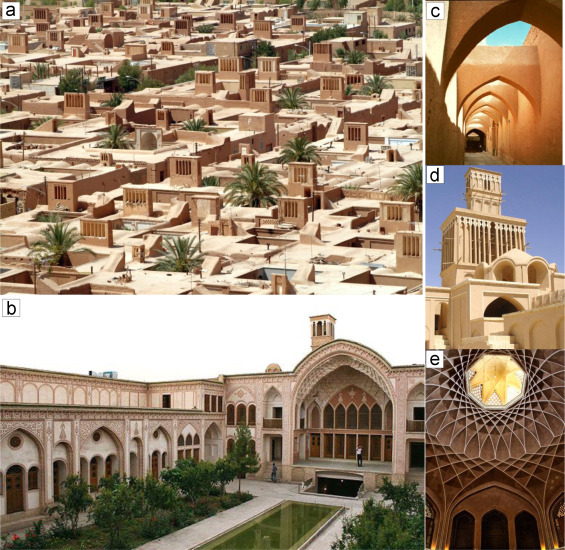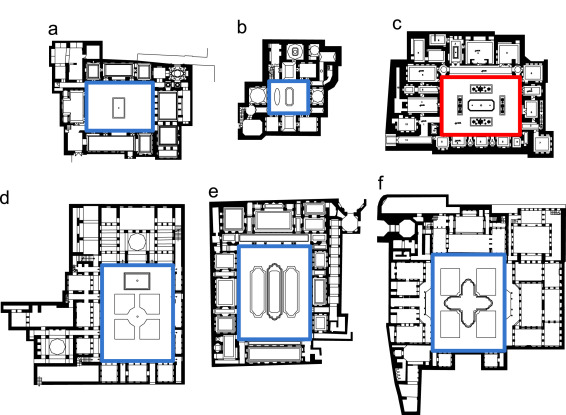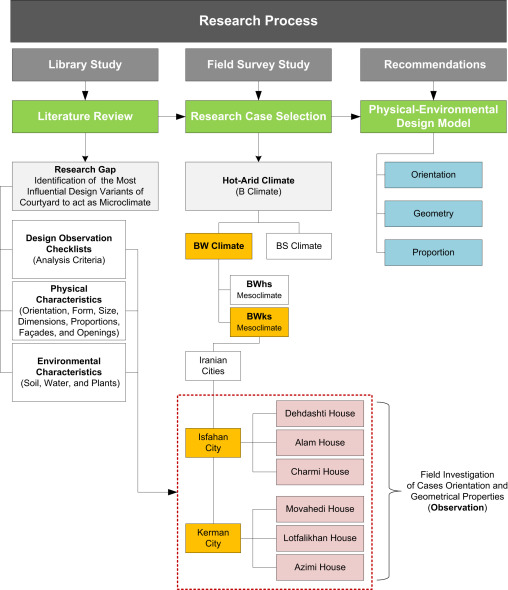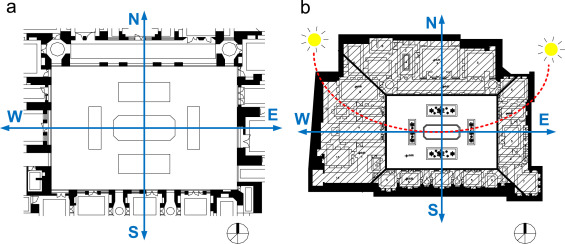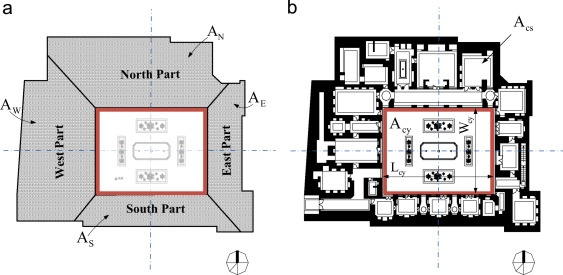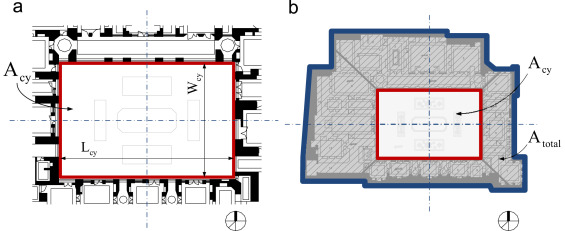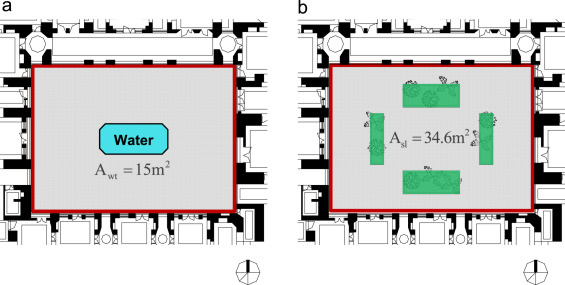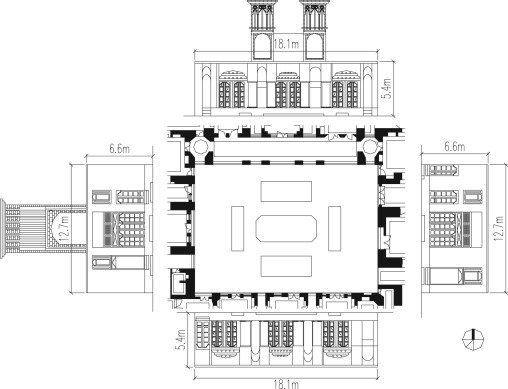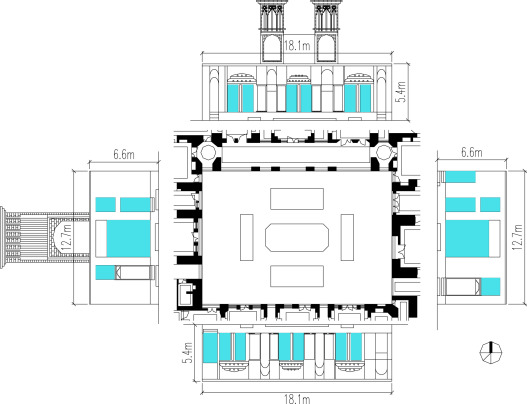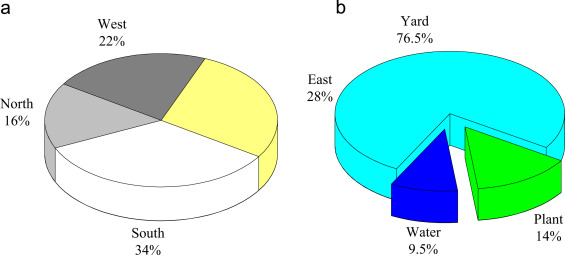Abstract
The effect of courtyards as microclimate modifiers on the sustainability of traditional houses in a region with BWks mesoclimate in Iran was explored. The principle behind traditional Iranian courtyards was investigated to identify the most influential physical–environmental characteristics that can effectively improve energy efficiency in contemporary residential buildings. A field study was performed to analyze various physical elements of six valuable traditional courtyard houses located in a region with BWks mesoclimate in Iran. These elements included the orientation, extension, rotation angle, dimensions, and proportions of enclosed and open spaces, as well as physical bodies (opaque walls), transparent surfaces (openings), and natural elements (water and soil). Results showed that most of the studied Iranian courtyards were particularly designed to enable orientation, dimension, and proportion to act as microclimate modifiers. All survey-based data were summarized and integrated to propose a physical–environmental design model for courtyards as a useful energy-efficient strategy for contemporary sustainable housing in a region with BWks mesoclimate. The proposed model can be generalized to all design cases located in areas with similar climatic conditions.
Keywords
Sustainable design ; Traditional Iranian courtyard ; Microclimate modifier ; Hot–dry climate ; BWks mesoclimate ; Physical–environmental design model
1. Introduction
Sustainable design is the philosophy of designing physical objects, building environments, and services to comply with the principles of social, economic, and ecological sustainability. Sustainable designs require nonrenewable resources, have minimal impact to the environment, and connect people with the natural environment (McLennan, 2004 ). Most modern buildings are designed without adequate attention to environmental impacts. The history of architecture exhibits a positive correlation between the environment and traditional buildings, which have been designed with careful attention to climatic requirements and sociocultural contexts. Traditional courtyard houses in the hot and dry region of Iran can also be considered successful climate-representative architecture that responds to many persistent environmental challenges. These houses use renewable solar and wind energies for passive heating and cooling to provide thermal comfort for their occupants. Traditional courtyard houses apply design principles such as compact urban fabrics, regular forms, optimal climatic orientations, dome-shaped roofs, high thermal capacity materials, courtyards as microclimate modifiers, and wind catchers as natural cooling systems (Figure 1 ).
|
|
|
Figure 1. Environmental sustainability of traditional courtyard houses in the hot and dry climate of Iran: (a) compact urban layout of the structure of the Chupanan Desert town, Isfahan; (b) traditional courtyards as microclimate modifiers, Kashan; (c) narrow enclosed alleys provide shade during summers, Yazd; (d) traditional wind catchers as natural cooling systems, Yazd; and (e) roof dome windows provide natural light, Kashan (Soflaee, 2004 ). |
The courtyard is one of the most important elements of traditional courtyard houses. The lexical root of the word “courtyard” was the word “Curtis,” with the Caucasian root, “Gherdh,” which means “fencing off.” The term was derived from medieval documents. Thus, a courtyard is a closed area in a house or other structures that is a vast uncovered space surrounded by rooms on some sides (Mahdavinejad et al., 2013 ).
Central courtyards have cooler air temperature primarily in the area above the courtyard and during mornings. A courtyard operates as follows. The air in the courtyard becomes warmer as the day progresses toward nighttime. Cool air is stored in the courtyard in laminar layers and flows into the rooms surrounding the courtyard. Then, the temperature in the courtyard slowly increases in the morning, allowing the courtyard to remain cool until solar radiation falls directly onto it. Warm wind passes over the house during the day. This wind does not enter the courtyard and merely creates eddies inside it, unless baffles are installed to deflect airflow. This phenomenon can be explained by the thermal properties of air and the material used in constructing the courtyard. The thermal capacity of the air is extremely low, and thus, the temperature of the courtyard is too close to the temperature of its surrounding surfaces. At night, the walls and floor of the courtyard are cooled down by long waves of outgoing radiation. Therefore, the surface of the floor and walls of the courtyard will remain cool until the following morning. Hence, most parts of the walls and floor of the courtyard (but not the air deposited in the courtyard) remain cool, that is, if they are not too large and are effectively shaded. Otherwise, a nonprotected courtyard can increase heat stress in and around the building (Soflaee, 2006 ).
The average size of courtyards is generally determined according to latitude, although the size of the land is influential to a certain extent. Courtyards are sufficiently narrow to maintain a shaded area during summer, and yet sufficiently wide to receive solar radiation during winter (Bonine, 1980 , Givoni, 1976 and Donham, 1960 ). Previous studies have found that the level of thermal comfort in a courtyard is determined by microclimatic factors, particularly, solar radiation and wind. The effects of these parameters have been evaluated by considering the orientation and geometric properties of a courtyard as the most influential design parameters to provide appropriate thermal comfort (Meir et al., 1995 ; Meir, 2000 ; Reynolds, 2002 ; Almhafdy et al., 2013 ).
This study focuses on traditional Iranian courtyards in a region with BWks mesoclimate to utilize the beneficial function of courtyards as microclimate modifiers in designing contemporary houses. The environmental concept of traditional Iranian courtyards was analyzed. The orientation, dimensions, and proportions of courtyards were given particular attention to propose a comprehensive physical–environmental model for designing contemporary low-energy housing.
2. Research background
Numerous studies on courtyard houses have been conducted in different countries (Wilbaux et al., 2000 , Knapp et al., 2006 and Rabbat, 2010 ). However, only a few works have studied traditional courtyard houses in Iran, which has one of the oldest civilizations in the world dating back to 3000 BCE (Edwards et al., 2005 ).
Some studies on the methods used to resolve thermal issues in the function of courtyards as microclimate modifiers have been conducted. Muhaisen and Gadi (2006) demonstrated that deep and long courtyards would reduce energy consumption because of the shading effect of their configuration. Hence, a shallow courtyard is more suitable for a cold climate because its configuration will increase solar gain and decrease heating loads during winter. Aldawoud (2008) asserted that integrating a courtyard could be energy efficient in all types of climate, particularly in hot–arid and hot–humid climates.
Some scholars have focused on the importance of design variant factors and highlighted that the thermal condition inside courtyards is highly dependent on the amount of solar radiation and wind. The effects of these parameters have been evaluated based on the orientation and geometric properties of a courtyard (Meir, 2000 , Reynolds, 2002 , Rajapaksha et al., 2003 and Tablada et al., 2005 ). Al-Masri and Abu-Hijleh (2012) deduced that the orientation, footprint size, and height of the walls that surround a courtyard could significantly affect thermal conditions inside a courtyard and its surrounding spaces. Meir et al. (1995) assessed semi-enclosed courtyards oriented toward the west and south in Negev Desert, Israel during four representative days in spring, summer, winter, and autumn. The results showed that an appropriate orientation of semi-enclosed courtyards could improve the thermal conditions of surrounding spaces. Heidari (2010) proposed a design guideline for courtyards in the desert climate of Yazd City based on the air movement and thermal comfort results of case studies. He concluded that humidity in the studied courtyards could be improved through landscaping, and a pond could significantly affect thermal comfort. The depth-to-width ratio of a courtyard is an important factor of airflow pattern.
In addition to field survey measurements, computer simulation tools are frequently used because they are fast and low-cost means to test alternatives to and scenarios of design variants (Al-Masri and Abu-Hijleh, 2012 and Berkovic et al., 2012 ). Ghaffarian Hoseini et al. (2015) evaluated the capability of unshaded courtyards to provide thermally comfortable outdoor spaces depending on different design configurations and scenarios, such as the orientation, height, and albedo of a wall enclosure, as well as the use of vegetation. They utilized the software ENVI-met to simulate the thermal performance of courtyards in the hot–humid climate of Kuala Lumpur, Malaysia. Their results showed that according to design parameters, such as building height ratio, abundant vegetation in a courtyard could provide an acceptable level of thermal comfort in the tropics and could be enjoyed by residents for a long duration during daytime and even at noon. Their study proved that only well-designed courtyards could present a valid option for sustainably built environments. Cho and Mohammadzadeh (2013) conducted a comprehensive study on thermal comfort analyses of traditional Iranian courtyards in Kashan using the EnergyPlus simulation program. Their results proved that traditional Iranian courtyards exhibited significant advantages in terms of the thermal performance of indoor spaces, particularly areas adjacent to the courtyard, in hot and dry climates. Malekzadeh and Loveday (2008) assessed the energy performance of typical Iranian housing designs as influenced by their adjacent outdoor space conditions. They predicted the thermal conditions of adjacent courtyards based on the thermal interaction between indoor and adjacent outdoor spaces, and then assessed their effect on outdoor thermal comfort.
A comprehensive literature review illustrates that many studies have used various methodologies to determine the effect of courtyards on the energy consumption of buildings. However, only a few studies have been performed on traditional Iranian courtyard houses, which were first constructed as early as the 6th millennium BCE (Mahdavinejad et al., 2013 ). Furthermore, most of these studies have described Iranian courtyard houses with prior attention to sociocultural characteristics and have not considered the environmental concept of courtyards in hot and arid climates, particularly in BWks mesoclimate. The present study investigates the physical–environmental characteristics of traditional Iranian courtyards as microclimate modifiers in a region with BWks mesoclimate to propose an appropriate design model for future sustainable housing, which is mostly designed with minimal attention to environmental impacts.
3. Research methodology
Literature review and survey studies were performed to collect data. A comprehensive literature review was conducted by focusing on sustainable architecture, climatic-responsive vernacular architecture, subdivisions in hot and arid climate regions in Iran, and traditional courtyard houses to identify the most influential design variants of courtyards as microclimate modifiers.
A field survey was conducted to locally evaluate the design characteristics of six valuable traditional courtyard houses in two ancient cities in Iran, namely, Isfahan and Kerman, which are located in a region with BWks mesoclimate. Cases were selected based on three levels: climate, cities, and courtyard houses in Iran.
Four climatic zones were identified in Iran based on the Köppen climate classification, as follows: A, hot–humid climate; B, hot–arid climate; C, mild–humid climate; and D, cold climate (Kasmai, 2005 ). This research focuses on B, i.e., hot–arid climate, which covers nearly two-thirds of Iran. This area receives nearly no rain for at least 6 months annually, and hence, is extremely dry and hot. Local meteorological data from several stations were statistically analyzed to classify Iranian cities climatically. Subsequently, hot–arid climate was subdivided into two types, namely, desert climate (BW) and steppe climate (BS). In addition, BW and BS were further subdivided into four mesoclimates, namely, BWhs, BWks, BShs, and BSks (Soflaei et al., 2015 ). This work focused on BW, particularly on the BWks mesoclimate of Iran (“B” stands for arid climate, “W” for desert climate, “k” for cold climate, and “s” for dry summer climate).
Kerman and Isfahan are the most ancient cities in the region with BWks mesoclimate in Iran. Recent discoveries indicate that the history of Isfahan can be traced back to the Paleolithic period, as shown by the artifacts found in the area, which date back to the Paleolithic, Mesolithic, Neolithic, Bronze, and Iron Ages (Assari and Mahesh, 2011 ). Meanwhile, the history of human settlements in Kerman dates back to the 4th millennium BCE. Valuable historical vestiges have been discovered in this area, which is considered one of the ancient regions of Iran. In Jiroft, for example, a previously unknown settlement that dates back to around 2500 BCE, has been established by archeologists (Levi, 1996 ).
According to the study conducted by the Iran Cultural Heritage, Handcrafts, and Tourism Organization (Haji-Qassemi and Karbassi, 1998 ), the six selected cases are among the best and valuable traditional courtyard houses in Iran. These houses were designed by famous Iranian architects who carefully considered both social and environmental aspects (Figure 2 ).
|
|
|
Figure 2. Six traditional Iranian courtyard houses: (a) Lotfalikhan House, Kerman; (b) Azimi House, Kerman; (c) Movahedi House, Kerman; (d) Dehdashti House, Isfahan; (e) Alam House, Isfahan; and (f) Charmi House, Isfahan. |
Traditional courtyards have been analyzed based on different approaches, such as historical, cultural, spatial, structural, ornamental, and constructional details. In this study, the thermal performance of courtyards was given particular importance.
Previous studies have found that thermal comfort level in a courtyard is determined by microclimatic factors, particularly solar radiation and wind. The effects of these two main parameters have been evaluated by considering the orientation, dimensions, and proportions of a courtyard as the most influential design variants in providing optimal thermal comfort (Meir et al., 1995 ; Meir, 2000 ; Reynolds, 2002 ; Rajapaksha et al., 2003 ; Rajapaksha, 2004 ; Fardeheb, 2007 ; Almhafdy et al., 2013 ; Toe and Kubota., 2015 ). Hence, in the present study, a case analysis on the following six main criteria was conducted:
- Orientation, extension, and rotation angle of the courtyard.
- Dimensions and proportions of enclosed spaces.
- Dimensions and proportions of open spaces.
- Dimensions and proportions of natural bodies (water and soil).
- Dimensions and proportions of the physical bodies (opaque walls) of the courtyard.
- Dimensions and proportions of the transparent surfaces (openings) of the courtyard.
Finally, all survey-based data were classified, integrated, and analyzed to propose a physical–environmental design model for courtyards as effective energy-saving technique for contemporary sustainable housing in a region with BWks mesoclimate (Figure 3 ).
|
|
|
Figure 3. Research process. |
4. Field investigation: environmental–physical analysis of traditional Iranian courtyards in a region with BWks mesoclimate
Six physical–environmental design characteristics of traditional Iranian courtyards in a region with BWks mesoclimate were investigated using the field measurement method.
4.1. Criterion 1: orientation, extension, and rotation angle of a courtyard
Previous studies have determined that the orientation and aspect ratio of a courtyard are two design variants critical to the microclimatic performance of this structure (Almhafdy et al., 2013 ). The amount of solar energy absorbed within an urban space, such as a courtyard, during a given period, is determined by the penetration of short-wave radiation into space and by the albedo of the entire system. Although the latter is considerably a function of material reflectivity, both factors are affected by the orientation and geometry of the courtyard (Meir, 2000 ).
Most traditional Iranian courtyard houses in hot–arid climate are formed along the north–south, northeast–southwest, or northwest–southeast directions, which are the best orientations to maximize the use of summer and winter living spaces, as well as service spaces at the east facade (receiving west daylight) acting as a buffer zone for heat (Pirnia, 2005 and Ghobadian, 2006 )
Despite the geographical location of different cities in hot–arid climate, spaces are mostly located in the northern part of a courtyard, which faces south, to absorb maximum radiation for passive heating and daylight during cold seasons. By contrast, spaces in the southern part of a courtyard face north to gain minimum radiation and maximum suitable airflow for passive cooling and natural ventilation during hot seasons. This seasonal movement between summer and winter spaces is among the human responses to climate conditions (Memarian and Sadoughi, 2011 ).
Figure 4 presents the analytical results of the Movahedi House in Kerman according to Criterion 1. The house and the courtyard were both oriented along the west–east direction without any rotation angle because of the appropriate local wind direction.
|
|
|
Figure 4. Analysis of Criterion 1 for the Movahedi House in Kerman. Orientation and rotation angle of the house (a) and the courtyard (b). |
Table 1 illustrates the analytical results of Criterion 1 for the six selected cases. The houses in each city were designed based on similar orientations and rotation angles by considering the local environmental condition.
| City | House | Orientation | Rotation (deg) | |
|---|---|---|---|---|
| Mesoclimate BWks | Kerman | Lotfalikhan | West–East | 0 |
| Azimi | West–East | 0 | ||
| Movahedi | West–East | 0 | ||
| Isfahan | Dehdashti | South–North | 0 | |
| Alam | South–North | 0 | ||
| Charmi | South–North | 0 |
4.2. Criterion 2: dimensions and proportions of enclosed spaces
The concept of the void has an important philosophical meaning within the Islamic culture of Iran. The open space of a courtyard, surrounded by rooms as enclosed spaces, is based on the metaphysical principle of unity in Islam. The void has a spiritual significance, and as a void, the courtyard is a symbol of the presence of the divine in all things (Nasr, 1987 ). This concept also has roots in Persian Islamic culture and in social perceptions that reflect a sense of introspection with respect to privacy in Islamic ideology. In addition to ideological, social, and cultural characteristics, the climatic function of the traditional central courtyard as a microclimate modifier to improve comfort conditions of the surrounding environment is another important factor. The courtyard creates a comfortable living environment with the seasonal use of all surrounding spaces. The north and sunny side of a courtyard is used during winter, whereas the south and shaded side is used during summer (Soflaei et al., 2015 ).
Criterion 2 involves the dimensions and proportions of enclosed spaces. Figure 5 illustrates four divisions of enclosed spaces, particularly the living spaces at the northern, southern, western, and eastern parts of the Mahdavi House in Kerman. The open space, i.e., the courtyard, is also shown.
|
|
|
Figure 5. Analysis of Criterion 2 for the Movahedi House in Kerman: (a) areas assigned to enclosed spaces in the north, south, west, and east of the courtyard; and (b) enclosed and open spaces. |
Table 2 shows the different areas assigned to the enclosed spaces for the six selected courtyards. The total area of the houses is indicated as . Meanwhile, the total areas of the open and closed spaces in each courtyard house are indicated in Table 2 as and , respectively. The closed space in each case was similarly divided, and the related area of each part was calculated based on the as-built dimensions. The last four columns of Table 2 show the ratios between the northern, southern, eastern, and western parts of the closed space to the total area of the closed space. The results illustrate that the majority of the closed areas among all the cases is assigned to the northern part.
| City | House | ||||||||||||
|---|---|---|---|---|---|---|---|---|---|---|---|---|---|
| Mesoclimate BWks | Kerman | Lotfalikhan | 686 | 166 | 520 | 148 | 116 | 143 | 115 | 28% | 22% | 28% | 22% |
| Azimi | 404 | 67 | 337 | 133 | 72 | 62 | 70 | 39% | 21% | 18% | 21% | ||
| Movahedi | 937 | 230 | 707 | 246 | 108 | 112 | 241 | 35% | 15% | 16% | 34% | ||
| Average | 34% | 20% | 21% | 26% | |||||||||
| Isfahan | Dehdashti | 1267 | 355 | 912 | 328 | 106 | 65 | 414 | 36% | 12% | 7% | 45% | |
| Alam | 1110 | 347 | 763 | 253 | 123 | 210 | 176 | 33% | 16% | 28% | 23% | ||
| Charmi | 2103 | 500 | 1603 | 473 | 151 | 540 | 440 | 30% | 9% | 34% | 27% | ||
| Average | 33% | 12% | 23% | 32% |
Atotal : Total house area, Acy : Area of courtyard, Acs : Total area of closed spaces, AN : Area of northern part, AS : Area of southern part, AE : Area of eastern part, and AW : Area of western part.
4.3. Criterion 3: dimensions and proportions of open spaces
Proportion is one of the determinant factors in architecture to perceive harmony. Harmony is the discipline and regularity between the components of a phenomenon. This item plays a significant role in standardizing architecture. Traditional Iranian architects also used special units of traditional measurements to design traditional buildings. This unit, called “Peimoun” in Persian, is based on the system of human body proportions, such as “Arash” (40 cm), which is the distance from the elbow to the end of the fingers; “Gaz” (60 cm), which is equal to the length of 24 fingers, and “Govar” (1.60 cm), which is the distance from the fingers of the right hand to those on the left hand when they are completely stretched. Each part of a traditional building is measured based on this module, which can be divided into smaller submodules for a detailed design to reduce the diversity of sizes, as well as for the easy building and matching of components. In terms of building form, traditional Iranian architects use the modular geometric design method. They use a golden rectangular design, which is drawn inside a regular hexagon, with specific proportions of width and length (Pirnia, 2005 ).
The geometry, dimensions, and proportions of a courtyard, particularly the height-to-width ratio, are among the most influential parameters to improve the thermal performance of surrounding spaces (Meir, 2000 ; Almhafdy et al., 2013 ). Thus, Criterion 3 considers the form and dimensions of traditional courtyards with reference to the length, width, and height, as well as their proportions, namely, height-to-length, height-to-width, and length-to-width ratios. The best form, as well as the appropriate dimensions and proportions of central courtyards, was identified for courtyards that functioned as microclimate modifiers for energy-efficient contemporary buildings. Figure 6 illustrates the dimensions and areas of the open space, as well as the total area and the area assigned to the courtyard, in the Movahedi House in Kerman.
|
|
|
Figure 6. Analysis of Criterion 3 for the Movahedi House in Kerman: (a) area assigned to the courtyard and house and (b) the form, dimensions, and area of the courtyard. |
Table 3 presents a summary of the analytical results for Criterion 3 of the six houses. All the cases had rectangular courtyards. The results indicate that the maximum proportions of the courtyard area to the total area among all the cases are 18% and 32%, respectively. However, the average ratio was less than 30%. The length-to-width ratio of a courtyard is one of the significant factors among courtyard geometric properties. The average results show that the length-to-width ratio of the courtyard is nearly close. Given that these cases are among the most appropriate courtyard houses in this climate zone, their average proportions can be used as a design pattern for contemporary buildings. In terms of other proportions, the houses followed similar patterns, except for the Azimi House, which had slightly different proportions.
| City | House | ||||||||||
|---|---|---|---|---|---|---|---|---|---|---|---|
| Mesoclimate BWks | Kerman | Lotfalikhan | 15 | 11 | 5 | 165 | 0.33 | 0.45 | 1.36 | 24% | Rectangular |
| Azimi | 10 | 7.4 | 5.6 | 74 | 0.56 | 0.76 | 1.35 | 18% | Rectangular | ||
| Movahedi | 18.1 | 12.7 | 6 | 230 | 0.33 | 0.47 | 1.43 | 25% | Rectangular | ||
| Average | 0.41 | 0.56 | 1.38 | 22% | |||||||
| Isfahan | Dehdashti | 22 | 16.5 | 6.6 | 363 | 0.30 | 0.40 | 1.33 | 29% | Rectangular | |
| Alam | 21.4 | 16.5 | 7.4 | 353 | 0.35 | 0.45 | 1.30 | 32% | Rectangular | ||
| Charmi | 26 | 19.3 | 7.35 | 502 | 0.28 | 0.38 | 1.35 | 24% | Rectangular | ||
| Average | 0.31 | 0.41 | 1.33 | 28% |
: Courtyard length, : Courtyard width, : Average height of courtyard, : Area of courtyard, : Shape of courtyard.
4.4. Criterion 4: dimensions and proportions of natural bodies (water and soil)
As an ecosystem, the traditional Iranian courtyard consists of natural bodies that can be divided into two major categories, namely, water and soil. Various types of water bodies, such as pools, have been used in traditional central courtyards. Pools are designed in various shapes, mostly rectangular. A pool is usually located at the center of a traditional courtyard and is frequently constructed along one of the main axes of the house (Tofan, 2006 ). Pools are generally shallow to increase the solar absorption of the water surface, increase evaporation to provide more humidity and decrease the dryness of air, and create convective breezes to provide the passive cooling and natural ventilation of each house. In addition, soil, as a thermal mass, can be coupled with night ventilation if the stored heat will be delivered to the space during nighttime (Santamouris and Asimakoupolos, 1996 ). Green surfaces, including low water-usage trees and native plants, which are selected because of their adaptation to hot–arid climate, also play an important role in balancing shaded and sunny areas during different seasons. Plants can contribute to the natural cooling of interior spaces via shading during summer to decrease radiation gain through the floor and facades of the courtyard. Moreover, plants increase the absorption of radiation through the floor and bodies of the courtyard to provide passive solar heating in indoor spaces during winter.
Thus, the dimensions and proportions of water and soil as natural bodies in the traditional central courtyards of the six houses were investigated. The appropriate ratios of the areas assigned to water, soil, and plants to the total area of the courtyard were determined based on the as-built dimensions in the selected cases. The appropriate proportion of the area assigned to water may significantly increase humidity in the courtyard, whereas the appropriate ratio of soil and plants to the total area of the courtyard can provide suitable shading or sunlight during different seasons.
Figure 7 shows the areas assigned to the water and plants in the Movahedi House in Kerman, in which 15 m2 and 34.6 m2 have been assigned to water and plants, respectively.
|
|
|
Figure 7. Analysis of Criterion 4 for the Movahedi House in Kerman: (a) area assigned to water in the courtyard and (b) area assigned to soil and plants in the courtyard. |
Table 4 provides a summary of the analytical results of Criterion 4 for the six selected houses. The areas assigned to water and soil were rectangular in nearly all cases. The average ratio of the area of water to the courtyard was 9.5% for all six cases; however, the houses in Isfahan assigned larger areas for water bodies and fountains. Moreover, the average ratio of the soil area in these courtyard houses showed that the courtyard houses in Isfahan assigned larger areas to soil and plants, compared with the houses in Kerman. Meanwhile, the Lotfalikhan House has no allotted area for soil and plants because of the water shortage in Kerman, unlike in Isfahan, which is close to the Zayandehrud River that irrigates plants in the entire city.
| City | House | |||||||||
|---|---|---|---|---|---|---|---|---|---|---|
| Mesoclimate BWks | Kerman | Lotfalikhan | 1 | Rectangular | 13 | 8% | 0 | Rectangular | 0 | 0% |
| Azimi | 1 | Rectangular | 7.2 | 11% | 1 | Rectangular | 3.6 | 5% | ||
| Movahedi | 1 | Rectangular | 15 | 7% | 4 | Rectangular | 34.6 | 15% | ||
| Average | 8% | 7% | ||||||||
| Isfahan | Dehdashti | 1 | Rectangular | 23 | 6% | 4 | Rectangular | 74 | 21% | |
| Alam | 1 | Rectangular | 40 | 12% | 2 | Rectangular | 74 | 21% | ||
| Charmi | 1 | Rectangular | 76 | 15% | 4 | Rectangular | 104 | 21% | ||
| Average | 11% | 21% |
: Number of area assigned to water in courtyard, : Shape of area assigned to water in courtyard, : Total area assigned to water in courtyard, : Number of area assigned to soil in courtyard, : Shape of area assigned to soil in courtyard, : Total area assigned to soil in courtyard.
4.5. Criterion 5: dimensions and proportions of the physical bodies (opaque walls) of a courtyard
The facades of traditional central courtyards in hot–arid regions protect indoor spaces from gaining heat and high outdoor temperature. Thus, the dimensions, proportions, and in particular, the heights of the northern, southern, western, and eastern elevations of a courtyard, generally vary. The higher facades of traditional Iranian central courtyards with a rectangular shape and a north–south extension are situated at the northern and southern sides. This characteristic prevents the direct gain of solar radiation by the higher facades, whereas the shorter facades at the western and eastern sides gain sunlight and heat directly during summer, but not during winter (Soflaei et al., 2015 ).
Thus, the dimensions and proportions of the northern, southern, eastern, and western elevated areas of the traditional central courtyards in the six houses were investigated. The appropriate dimensions and proportions of the facades, particularly facade height and the ratio of the area of each facade to the total area of facades in a courtyard, were investigated. This pattern can provide the most appropriate shading or sunlight during different seasons based on the similar patterns of the majority of the traditional courtyards in this climate zone.
Figure 8 shows the four facades of the Movahedi House in Kerman at the northern, southern, eastern, and western portions. The heights of the elevations in the eastern and western sections are higher than those in the northern and southern sections in the Kerman houses. By contrast, the Isfahan houses have higher elevations at the northern and southern parts because of the orientation of the houses. Table 5 presents a summary of the analytical results of Criterion 5 for the six houses. The data show that the north facades have the maximum ratio of the facade area to the total elevated areas.
|
|
|
Figure 8. Analysis of Criterion 5 for the Movahedi House in Kerman: (a) dimensions and proportion of the physical bodies, and the (b) south and (c) north elevations of the courtyard. |
| City | House | |||||||||||||
|---|---|---|---|---|---|---|---|---|---|---|---|---|---|---|
| Mesoclimate BWks | Kerman | Lotfalikhan | 68 | 72 | 62 | 51 | 4.5 | 4.8 | 5.6 | 4.6 | 27% | 28% | 25% | 20% |
| Azimi | 52 | 52 | 41 | 41 | 5.2 | 5.2 | 5.5 | 5.5 | 28% | 28% | 22% | 22% | ||
| Movahedi | 98 | 98 | 84 | 84 | 5.4 | 5.4 | 6.6 | 6.6 | 27% | 27% | 23% | 23% | ||
| Average | 5.0 | 5.1 | 5.9 | 5.6 | 27% | 28% | 23% | 22% | ||||||
| Isfahan | Dehdashti | 122 | 90 | 124 | 124 | 7.4 | 5.5 | 5.6 | 5.6 | 27% | 20% | 27% | 27% | |
| Alam | 153 | 77 | 115 | 115 | 9.3 | 4.7 | 5.4 | 5.4 | 33% | 17% | 25% | 25% | ||
| Charmi | 169 | 108 | 147 | 147 | 8.8 | 5.6 | 5.7 | 5.7 | 30% | 19% | 26% | 26% | ||
| Average | 8.5 | 5.2 | 5.6 | 5.6 | 30% | 18% | 26% | 26% |
ANel : Area of courtyard north elevation, Asel: Area of courtyard south elevation, AEel : Area of courtyard east elevation, AWel : Area of courtyard west elevation, ATel : Total area of elevations, HNel : Courtyard height in north elevation, HSel : Courtyard height in south elevation, HEel : Courtyard height in east elevation, HWel : Courtyard height in west elevation.
4.6. Criterion 6: dimensions and proportions of the transparent surfaces (openings) of a courtyard
The dimensions and proportions of openings in traditional courtyards are diverse in various facades to provide passive heating or natural cooling to residents during different seasons. In the south facade of traditional central courtyards, the windows are immovable. Moreover, the south facade of most traditional courtyards has no top windows because of the presence of sash-windows with vertical openings. Therefore, indoor spaces benefit from natural ventilation through these sash-windows. Similar to that in the south facade, sash-windows with vertical openings are found in the north facade. Humidity and cool air in the central courtyard can be overcome by opening the sash-windows at nighttime because no wind catcher is installed in this part of the house.
The north facade has rooms with three or five doors, namely, Se-dary or Panj-dary, respectively. The function of these rooms is similar to providing indoor thermal comfort by reducing indoor temperature fluctuations during winter. Moreover, a symmetrical north elevation can be observed in all the cases because of the similar sunlight conditions in all the winter rooms. The east and west facades have large movable windows with wooden lattice frames, which are appropriate for autumn and spring because of the high intensity of solar gain in these facades.
The areas assigned to the openings in the north, south, east, and west elevations of the traditional central courtyards, as well as the ratio of the total opening area to the total area of each facade, were investigated for the six houses. In terms of the area of openings and its proportion to corresponding facades, the pattern adopted in designing traditional Iranian courtyard houses located in the BWks climate zone may provide passive heating or cooling to residents through appropriate shading or sunlight during different seasons.
Figure 9 shows the openings of elevations in different facades of the Movahedi House in Kerman. The areas assigned to the openings in this courtyard house in the east and west facades are greater than those in the north and south facades, which can also be observed in all the Kerman houses. By contrast, the Isfahan houses have greater opening areas assigned to the north and south facades. This discrepancy is attributed to the different orientations of the houses in the two cities to provide thermal comfort and appropriate shading in these houses. Regardless of environmental aspects, symmetry, rhythm, and harmony were appropriately considered in designing the openings in the case of the Movahedi House, which can provide a pleasant and suitable place for living.
|
|
|
Figure 9. Analysis of Criterion 6 (dimensions and proportion of openings) for the Movahedi House in Kerman. |
Table 6 provides a summary of the analytical results of Criterion 6 for the six houses. The maximum ratio of the average opening area in the Kerman houses is in the east elevation, whereas that in the Isfahan houses is in the north elevation. However, the effects of local conditions and esthetic features cannot be neglected in designing openings, particularly in terms of their numbers and assigned areas in the six houses.
| City | House | |||||||||
|---|---|---|---|---|---|---|---|---|---|---|
| Mesoclimate BWks | Kerman | Lotfalikhan | 15 | 20 | 17.3 | 11.7 | 22% | 28% | 28% | 23% |
| Azimi | 12 | 15 | 10 | 10 | 23% | 29% | 24% | 24% | ||
| Movahedi | 16 | 20 | 27 | 23 | 16% | 20% | 32% | 27% | ||
| Average | 20% | 26% | 28% | 25% | ||||||
| Isfahan | Dehdashti | 42 | 32 | 37 | 37 | 34% | 36% | 30% | 30% | |
| Alam | 32 | 21 | 30 | 30 | 21% | 27% | 26% | 26% | ||
| Charmi | 77 | 30 | 44 | 44 | 46% | 28% | 30% | 30% | ||
| Average | 34% | 30% | 29% | 29% |
: Area of openings in courtyard north elevation, : Area of openings in courtyard south elevation, : Area of openings in courtyard east elevation, : Area of openings in courtyard west elevation.
5. Physical–environmental analysis results of the city cases
In this section, the design pattern of courtyard houses at the city level was identified according to the results in Section 4 . These cities include Kerman and Isfahan, which are located in a region with a BWks mesoclimate; the selected courtyard houses are among the best traditional courtyard houses in Iran.
Table 7 provides a summary of the analytical results of the six criteria presented in an appropriate model for designing courtyard houses in Kerman and Isfahan.
| Criterion | Parameter | Kerman | Isfahan |
|---|---|---|---|
| No. 1 | 34% | 33% | |
| 20% | 12% | ||
| 21% | 23% | ||
| 26% | 32% | ||
| No. 2 | Orientation | W–E | S–N |
| Rotation | |||
| No. 3 | 0.41 | 0.31 | |
| 0.56 | 0.41 | ||
| 1.38 | 1.33 | ||
| 22% | 28% | ||
| No. 4 | 8% | 11% | |
| 7% | 21% | ||
| No. 5 | 27% | 30% | |
| 28% | 18% | ||
| 23% | 26% | ||
| 22% | 26% | ||
| No. 6 | 20% | 34% | |
| 26% | 30% | ||
| 28% | 29% | ||
| 25% | 29% |
The results of Criterion 1 show that traditional courtyard houses in Kerman and Isfahan do not have similar orientations because of their different latitudinal locations and local environmental conditions. However, rotation angles are identical among all the cases.
For Criterion 2, the maximum area in the enclosed spaces is assigned to the northern part, with an average of 33.5%. However, the total areas assigned to the eastern and western parts are sometimes greater than those assigned to the northern and southern parts because of the local restrictions in some cases.
The results of Criterion 3 illustrates that high level of thermal comfort is achieved by rectangular courtyards with a length-to-width ratio ranging from 1.33 to 1.38. The proportions of length and width to the average height of a courtyard are also provided in this section. More accurate results will be obtained when the proportion of each elevation are considered separately because of the differences in the heights of facades around the courtyard.
The areas assigned to water, soil, and plants inside the courtyard are discussed under Criterion 4. The average areas assigned to water in the Kerman and Isfahan are 8% and 11%, respectively, whereas 7% and 21% of the courtyard area is assigned to plants in the Kerman and Isfahan houses, respectively. This discrepancy is caused by the water shortage in Kerman, whereas Isfahan is close to the Zayandehrud River, which irrigates plants in the entire city.
The dimensions and proportions of physical bodies, which are considered in Criterion 5, show that the total area assigned to the south and north elevations are nearly close to the total area of the east and west elevations because different heights are considered in the elevations.
Results of the analysis for Criterion 6 for the two cities indicate that the maximum areas of openings are assigned to the east and north elevations for the Kerman and Isfahan houses, respectively.
6. Proposed design model for courtyards in the BWks mesoclimate zone
Finally, a design model is presented in this section for courtyard houses in the BWks mesoclimate zone based on the sizes, dimensions, and proportions of traditional Iranian courtyard houses through the six physical–environmental criteria.
The average results show that the majority of the area should be assigned to the southern part of the enclosed space of the courtyard houses, with a ratio of 34%. However, the total areas of the northern and southern sections are identical with the eastern and western sections (Figure 10 a).
|
|
|
Figure 10. Proposed area for assigning enclosed spaces and natural bodies: (a) north, south, east, and west sides of an enclosed space and (b) area of water and plants as natural bodies. |
The south–north or west–east direction without a rotation angle can be considered the appropriate orientation for courtyards. However, the local geographic and environmental conditions, as well as the latitudinal location, cannot be neglected.
A model based on the proportions of length, width, and height was proposed based on the analytical results of the six criteria. Linear fitting was adopted, and the best line matched with scatters was determined. The results of this fitting process and the regression R values are provided in Figure 11 . Three linear equations were proposed to design courtyards based on geometric proportions. The best relationship between the length and width of a courtyard was obtained based on the following equation:
|
|
( 1) |
|
|
|
Figure 11. Proportions of length, width, and height of the central courtyards: (a) length vs. height, (b) width vs. height, and (c) width vs. length. |
According to the average results reported in Section 5 , approximately 24% of courtyard can be assigned to natural elements, particularly, 10% for water and 14% for plant. This ratio can provide appropriate thermal comfort in a courtyard and its surrounding areas as the observation results and previous studies have demonstrated (Figure 10 b).
The total areas of the facades in the northern, southern, eastern, and western sections of the courtyard can be considered to be nearly identical, but the heights of the surrounding bodies should be designed differently. The heights of the facades in the northern and southern sections should be higher than the east and west elevations. Meanwhile, the courtyard extension can be in the south–north direction.
Openings in elevations can be designed based on the ratio of the area of the total openings to its corresponding elevation by 20–34%. This ratio can be considered similar in different elevations. However, a relationship exists between this ratio and courtyard size that can alter the amount of this proportion.
7. Conclusion
The BWks mesoclimate zone was identified in the hot–arid climate region of Iran based on the Köppen climatic classification. Six physical–environmental analytical criteria for traditional courtyards as microclimate modifiers were defined and used to examine six remarkable traditional Iranian courtyard houses in Kerman and Isfahan, ancient cities located in the BWks mesoclimate zone. The sizes, dimensions, and proportions of the physical and natural elements of traditional courtyards were identified, and logical relationships among these elements were determined. Recommendations were outlined for designing courtyards as effective microclimate modifiers by considering the orientation and geometric properties of their physical and natural elements. Design equations were proposed as functions of the proportions and dimensions (length, width, and height) of the courtyards. The design model and recommendations can be used to design contemporary sustainable buildings in the BWks mesoclimate zone. The results can be generalized to other climate zones by performing future similar investigations.
Acknowledgments
The authors would like to express their gratitude to the Iran Cultural Heritage, Handcrafts, and Tourism Organization , as well as to the Islamic Azad University, Science and Research Branch , in Iran for their support.
References
- Aldawoud, 2008 A. Aldawoud; Thermal performance of courtyard buildings; Energy Build., 40 (5) (2008), pp. 906–910
- Al-Masri and Abu-Hijleh, 2012 N. Al-Masri, B. Abu-Hijleh; Courtyard housing in midrise buildings: An environmental assessment in hot-arid climate; Renew. Sustain. Energy Rev., 16 (4) (2012), pp. 1892–1898
- Almhafdy et al., 2013 A. Almhafdy, N. Ibrahim, S.S. Ahmad, J. Yahya; Courtyard design variants and microclimate performance; Procedia-Soc. Behav. Sci., 101 (2013), pp. 170–180
- Assari and Mahesh, 2011 A. Assari, T.M. Mahesh; Demographic comparative in heritage texture of Isfahan city; J. Geogr. Reg. Plan. Acad. J., 4 (8) (2011), pp. 463–470
- Berkovic et al., 2012 S. Berkovic, A. Yezioro, A. Bitan; Study of thermal comfort in courtyards in a hot arid climate; Sol. Energy, 86 (5) (2012), pp. 1173–1186
- Bonine, 1980 M.E. Bonine; Aridity and Structure; Desert Housing, New York. (1980)
- Cho and Mohammadzadeh, 2013 Cho, S., Mohammadzadeh, N., 2013. Thermal comfort analysis of a traditional Iranian courtyard for the design of sustainable residential buildings. In: Proceedings of 13th Conference of International Building Performance Simulation Association, Chambéry, France.
- Donham, 1960 D. Donham; The courtyard house as a temperature regulator; New Sci., 8 (1960), pp. 663–666
- Edwards et al., 2005 B. Edwards, M. Sibley, M. Hakmi, P. Land; Courtyard Housing: Past, Present and Future; Taylor and Francis (2005)
- Fardeheb, 2007 Fardeheb, F., 2007. Passive cooling ability of a courtyard house in a hot and arid climate: a real case study. In: Proceedings of ISES World Congress, vol. I–V, pp. 2516–2520.
- Ghaffarian Hoseini et al., 2015 A. Ghaffarian Hoseini, U. Berardi, A. Ghaffarian Hoseini; Thermal performance characteristics of unshaded courtyards in hot and humid climates; Build. Environ., 87 (2015) (2015), pp. 154–168
- Ghobadian, 2006 V.A. Ghobadian; Survey on the Climatic Design of the Iranian Traditional Buildings (in Persian); Tehran University, Iran (2006)
- Givoni, 1976 B. Givoni; Man, Climate and Architecture; Applied Science Publisher Ltd., Amsterdam (1976)
- Haji-Qassemi and Karbassi, 1998 K. Haji-Qassemi, C. Karbassi; Ganjnameh: Cyclopedia of Iranian Islamic Architecture (Volume 4: Mansions of Esfahan); Shahid Beheshti University, Cultural Heritage Organization (1998)
- Heidari, 2010 Sh. Heidari; A deep courtyard as the best building form for desert climate, an introduction to effects of air movement (Case study: Yazd); Desert, 15 (2010), pp. 19–26
- Kasmai, 2005 M. Kasmai; Climate and Architecture (in Persian); Khak Publication, Iran (2005), pp. 117–127
- Knapp et al., 2006 R.G. Knapp, J. Spence, A. Chester Ong; Chinese Houses: The Architectural Heritage of a Nation; Tuttle Publishing, Singapore (2006)
- Levi, 1996 A.H.T. Levi; Trudy Ring (Ed.), "Kerman" in International Dictionary of Historic Places, vol. 4, Fitzroy Dearborn, Chicago (1996) (p. 413)
- Mahdavinejad et al., 2013 M. Mahdavinejad, A. Moradchelleh, S. Dehghani, S.M. Mirhosseini; The adoption of central courtyard as a traditional archetype in contemporary architecture of Iran; World Appl. Sci. J., 21 (6) (2013), pp. 802–811
- Malekzadeh and Loveday, 2008 Malekzadeh, D., Loveday, L., 2008. Towards the integrated thermal simulation of indoor and outdoor building spaces. In: Proceedings of Conference: Air Conditioning and the Low Carbon Cooling Challenge, Cumberland Lodge, Windsor, UK, London, pp. 27–29.
- McLennan, 2004 J.F. McLennan; The Philosophy of Sustainable Design: The Future of Architecture; Ecotone Publishing (2004)
- Meir, 2000 Meir, I.A., 2000. Courtyard microclimate: a hot arid region case study. Paper Presented at the Proceedings of the 17th PLEA International Conference, Cambridge.
- Meir et al., 1995 I.A. Meir, D. Pearlmutter, Y. Etzion; On the microclimatic behavior of two semi-enclosed attached courtyards in a hot dry region; Build. Environ., 30 (4) (1995), pp. 563–572
- Memarian and Sadoughi, 2011 G. Memarian, A. Sadoughi; Application of access graphs and home culture: examining factors relative to climate and privacy in Iranian houses; Sci. Res. Essays, 6 (30) (2011), pp. 6350–6363
- Muhaisen and Gadi, 2006 A.S. Muhaisen, M.B. Gadi; Effect of courtyard proportions on solar heat gain and energy requirement in the temperate climate of Rome; Build. Environ., 41 (2006), pp. 245–253
- Nasr, 1987 S.H. Nasr; Islamic Art and Spirituality; State University of New York Press, New York (1987)
- Pirnia, 2005 M.K. Pirnia; Introduction to Islamic Architecture in Iran; 10, Soroosh Danesh, Iran (2005)
- Rabbat, 2010 N.O. Rabbat; The Courtyard House: From Cultural Reference to Universal Relevance. Ashgate, Published in Association with the Aga Khan Program for Islamic Architecture; Massachusetts Institute of Technology, USA (2010)
- Rajapaksha et al., 2003 I. Rajapaksha, H. Nagai, M. Okumiya.; A ventilated courtyard as a passive cooling strategy in the warm humid tropics; Renew. Energy, 28 (11) (2003), pp. 1755–1778
- Rajapaksha, 2004 U. Rajapaksha; An Exploration of Courtyards for Passive Climate Control in Non-domestic Buildings in Moderate Climates (Doctoral dissertation); The School of Geography, Planning and Architecture, the University of Queensland, Australia (2004)
- Reynolds, 2002 J. Reynolds; Courtyards: Aesthetic, Social, and Thermal Delight; Wiley (2002)
- Santamouris and Asimakoupolos, 1996 M. Santamouris, D. Asimakoupolos; Passive Cooling of Buildings; James & James (Science Publishers), UK (1996)
- Soflaee, 2004 Soflaee, F., 2004. Sustainability of climatic-sensitive elements in the Iranian traditional architecture of hot–arid regions (in Persian). In: Proceedings of the 3rd International Conference on Fuel Conservation in Building, Tehran, Iran. pp 133–154.
- Soflaee, 2006 Soflaee, F., 2006. Environmental effect of courtyard in sustainable architecture of Iran (hot-arid regions), case study: courtyard houses in Yazd, Kashan & Semnan. In: Proceedings of the International Conference of Arab Regional Solar Energy, Bahrain, pp. 343–354.
- Soflaei et al., 2015 F. Soflaei, M. Shokouhian, S.M. Mofidi; Investigation of Iranian traditional courtyard as passive cooling strategy (a field study on BS climate); Int. J. Sustain. Built Environ. (2015) http://dx.doi.org/10.1016/j.ijsbe.2015.12.001
- Tablada et al., 2005 Tablada, A., Blocken, B., Carmeliet, J., De Troyer, F., Verschure, H., 2005. The influence of courtyard geometry on air flow and thermal comfort: CFD and thermal comfort simulations. In: Proceedings of the PLEA 2005, 22nd Conference on Passive and Low Energy Architecture, Beirut, Lebanon.
- Toe and Kubota., 2015 D.H.C. Toe, T. Kubota.; Comparative assessment of vernacular passive cooling techniques for improving indoor thermal comfort of modern terraced houses in hot-humid climate of Malaysia; Sol. Energy, 114 (2015), pp. 229–258
- Tofan, 2006 S. Tofan; Recognition of water’s role in Iran’ traditional courtyard houses; Gard. View, 6 (2006), pp. 75–77
- Wilbaux et al., 2000 Q. Wilbaux, M. Lebrun, K. McElhearn; Marrakesh: The Secret of Courtyard Houses; Art Creation Realisation, France (2000)
Document information
Published on 21/07/16
Licence: Other
Share this document
Keywords
claim authorship
Are you one of the authors of this document?
